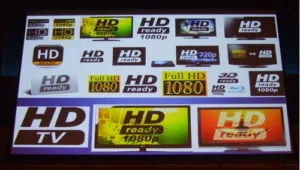Andrew Uden is the senior technical manager at UK supermarket chain, Asda, which is owned by Walmart. He spoke about developments in the TV industry, starting with an informal poll to see how many people owned an UltraHD TV – about eight out of the 150 – 200 audience members – and a connected smart TV – about half the audience. This largely reflects trends in the wider market, although as the audience was primarily display people, the penetration of UltraHD could be expected to be slightly higher than the average! (Then again, those who understand the real technical issues are not always “early adoptors” as they know where the ‘gotchas’ are! Man. Ed.)
There is a “bewildering array” of smart TV platforms, said Uden, which makes it easy to disappoint customers. When deciding which third-party ecosystem to use, Asda is driven by a single primary concern: what is the benefit to consumers throughout the lifetime of the product? Today, retailers must do much more to ‘keep a product sold’ after it leaves the store.
We now risk running into the same problem with UltraHD as we did with HD. The rollout of HD services in the UK took place around the same time as digital TV, and there were many, many logos (HD Ready, HD Ready 1080p, Full HD 1080 and HD TV, to name only a few). Uden said that customers at the time were confused by the conflicting messaging. Many confused the ability to receive HD programming with the ability to receive digital TV. With UltraHD, we must strive for consistent messaging.
In a recent survey, no Asda consumers knew what an UltraHD TV was – until it was described to them. After that, a few people admitted to owning one, but did not know it. Half of shoppers said that they were unsure what smart TV was. These responses weren’t limited to the UK, as a survey in Walmart in the USA returned similar responses. Uden reiterated the need to “demystify messaging” around smart TV and UltraHD.
Hewlett asked how big Freeview has been for Asda. Uden replied that the upcoming launch of Freeview Play, which aims to consolidate different smart TV platforms, will bring consistency to the service, which the customer is hungry for. If a product is sold based on its features and benefits, a customer has a right to expect them to be available for a number of years. There is a burden on retailers to continue supporting products, and with the constant updates to different platforms, support staff are being constantly retrained.
Uden also told Hewlett that while a lack of interoperability can lower sales, he understands the need to differentiate products.
An audience member asked a question that would be returned to several times throughout the day: UltraHD and 8K are not very well-defined, and his understanding is that retailers haven’t grasped that issue. Does Uden feel that it is safe to sell equipment that might not meet the ‘ultimate’ spec for delivery in 2-3 years? Uden said that this was a constant source of concern for retailers and is an issue that is consistently raised in product development. He acknowledged that brands need to move forward with technology to drive sales, but said that upgradeability is important.
Hewlett jumped, asking for clarification: “So you’re selling 4k TVs, with no guarantee that they will be able to receive future content?” Uden said that Asda has been working closely with the DTG and has had people come and give them “a good idea” of what might be coming in the future. Many TVs these days are UltraHD or ready for it – it will be hard to source a TV in two years that isn’t!
Barry Fox, a well-known technology writer for Consumer Electronics Daily, returned to an earlier point by Uden: manufacturers are using those magic words, “purport to be 4k”. They must choose their words carefully, he said, citing a complaint that he had lodged with the Advertising Standards Authority about 12 months ago, dealing with a TV sold by “a major manufacturer”. The TV was described as UltraHD, even though there were no standards at the time defining the format.

